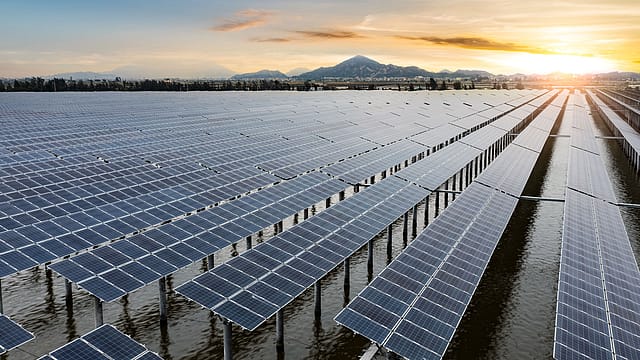Chinese companies dominate solar equipment market, despite PLI
ADVERTISEMENT

Despite imposing entry barriers and liberal production incentives to boost domestic production of solar equipment, Chinese companies still control the Indian market, says a study.
Adani Solar, in third position, is the only domestic manufacturer to feature in the top six solar module suppliers in India in 2022, says market research agency Mercom India's 'India Solar Market Leaderboard – 2023'. The top suppliers to Indian project developers are Jinko Solar, Trina Solar, Adani Solar, LONGi Solar, and JA Solar. Six Chinese companies figure among the top ten module suppliers. The top ten module suppliers accounted for 71% of the market at the end of 2022. Jinko Solar has a 13% market share followed by 11% for Trina Solar, 9% for Adani Solar, and 8% each market share for LONGi Solar and JA Solar, says the report.
India added 13.9 gigawatts (GW) of solar capacity in 2022. The top 10 large-scale solar developers in India accounted for over 65% of all utility-scale project installations. Avaada Energy was the leading developer with the most utility-scale solar installations last year. India's solar photovoltaic (PV) module manufacturing capacity had grown to 39 GW and cell capacity to 4.7 GW by the end of September 2022.
With a view to curb imports of solar equipment and boost domestic production, the government imposed a 40% basic customs duty (BCD) on solar cells and 25% on cells from April 1, 2022, besides coming out with an Approved List of Models and Manufacturers (ALMM) of domestic solar equipment.
January 2026
Netflix, which has been in India for a decade, has successfully struck a balance between high-class premium content and pricing that attracts a range of customers. Find out how the U.S. streaming giant evolved in India, plus an exclusive interview with CEO Ted Sarandos. Also read about the Best Investments for 2026, and how rising growth and easing inflation will come in handy for finance minister Nirmala Sitharaman as she prepares Budget 2026.
Sources say sufficient new Indian capacities under development will come up only by 2025-26 and Indian manufacturers are still working out plans for securing adequate ingredients going into their production plans and quality that can match the huge Chinese capacities.
In 2022, most of the supplies were from the inventory already stocked before the imposition of BCD. Furthermore, globally Chinese module prices had come down by 17-20% in the last few months. Even after paying the BCD, it is still viable to import good-quality Chinese cells and modules. Further, most of the Indian manufacturers who have set up capacities at present have supply constraints due to lucrative export orders, they say.
India's module manufacturing capacity is expected to reach 95 GW and cell capacity is expected to grow seven-fold to 32-35 GW by the end of 2025. Under the Production Linked Incentive Scheme (PLI) Tranche-1, the government is planning to add about 8.7GW of integrated manufacturing capacity and expects to have over 100 GW capacity by the end of 2026. Under the PLI Scheme for integrated domestic solar equipment manufacturing, the government has set aside ₹19,500 crore in two tranches.
